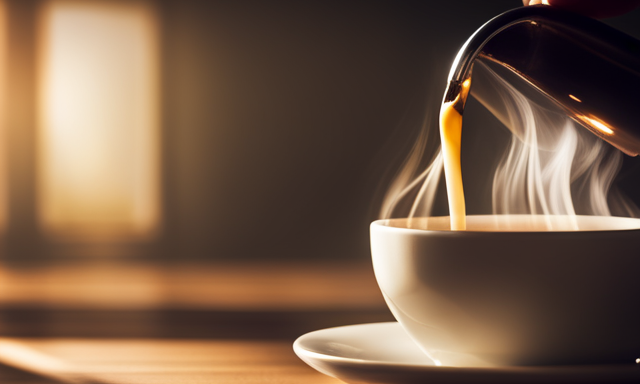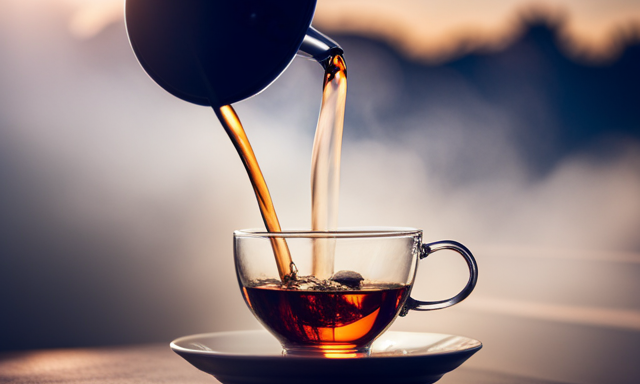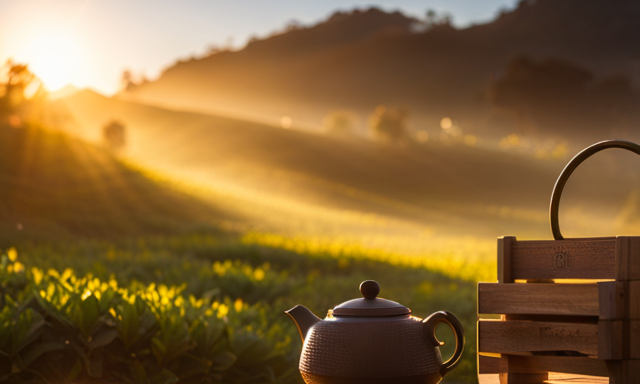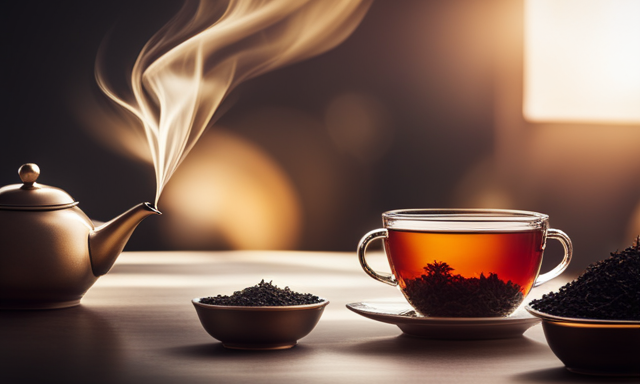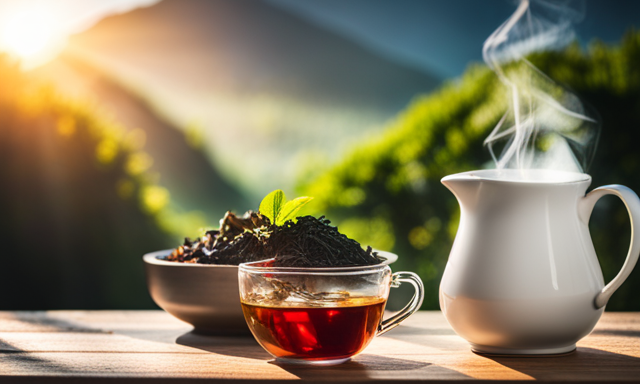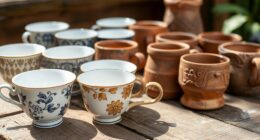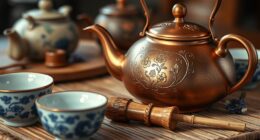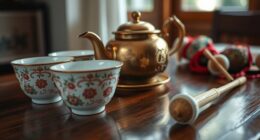Oolong tea, with its delicate balance of flavors and enticing aroma, is truly a beverage worth savoring. But do you know the secret to unlocking its full potential? It all comes down to the temperature.
Yes, you heard me right – the temperature! Finding that perfect range can make all the difference in the world of oolong tea brewing. Trust me, I’ve spent countless hours experimenting and refining my techniques to achieve that elusive, exquisite taste.
In this article, I will guide you through the intricate world of oolong tea brewing temperatures, sharing all the knowledge and tips I’ve gathered along the way. From the impact of temperature on flavor and aroma, to the various factors that can influence it, I’ve got you covered.
So grab your thermometer or electric kettle with temperature control, and let’s embark on a journey of discovering the ideal temperature for brewing the perfect cup of oolong tea.
Key Takeaways
- Adjusting temperature is important for brewing oolong tea, as it can enhance or subdue flavors.
- Using a slightly higher temperature for iced oolong tea helps prevent flavor dilution when chilled.
- Different oolong teas may require different water temperatures for optimal brewing.
- Experimenting with different water temperatures can help discover flavor nuances and find a preferred taste profile.
Understanding Oolong Tea Brewing Basics
To make the perfect cup of oolong tea, it is important to understand the basics of brewing it. Oolong tea is known for its complex flavors and unique characteristics that can vary greatly depending on how it is brewed.
One important factor to consider is the level of tea oxidation. Oolong tea falls between green and black tea in terms of oxidation, resulting in a wide range of flavors from light and floral to bold and roasted. By exploring these flavors, you can find the perfect balance that suits your taste.
Another crucial element that affects the taste of oolong tea is the temperature at which it is brewed. The temperature plays a significant role in bringing out the flavors and aromas of the tea leaves. Brewing oolong tea at too high of a temperature can result in a bitter or astringent taste, while brewing it at too low of a temperature may not extract the full range of flavors.
Understanding the ideal temperature for brewing oolong tea can enhance the overall experience and ensure that you are able to enjoy its unique characteristics to the fullest.
The Importance of Temperature in Oolong Tea Brewing
The impact of water quality, temperature, and steeping time on oolong tea flavor and aroma is significant. The temperature at which oolong tea is brewed plays a crucial role in bringing out its unique characteristics. Different temperatures can extract different compounds from the tea leaves, resulting in variations in taste and fragrance.
A higher temperature can bring out stronger flavors, while a lower temperature can highlight the tea’s delicate and floral notes. Furthermore, temperature also influences the health benefits of oolong tea. The antioxidants and polyphenols present in oolong tea are released at different rates depending on the temperature.
Achieving the ideal temperature range is essential to fully experience the flavors, aromas, and health benefits of oolong tea. Transitioning into the subsequent section about finding the ideal temperature range for oolong tea, it is important to consider various factors to enhance your brewing experience.
Finding the Ideal Temperature Range for Oolong Tea
To fully appreciate the flavors and aromas of your oolong tea, you’ll want to find the perfect temperature range. The ideal temperature for oolong tea can vary depending on the specific type of oolong and personal preference. However, there are some general guidelines to help you brew the perfect cup. Here are five brewing techniques to consider:
- Start with a temperature range of 180-200°F (82-93°C) for lighter oolong teas.
- For darker oolong teas, such as Wuyi or Da Hong Pao, a temperature range of 195-205°F (90-96°C) is recommended.
- Experiment with different temperatures within the range to find the sweet spot for your taste buds.
- Use a thermometer or an electric kettle with temperature control to ensure accuracy.
- Adjust the steeping time accordingly to prevent over-extraction or under-extraction.
By finding the ideal temperature range and using these brewing techniques, you can unlock the full potential of your oolong tea.
Now, let’s explore the impact of temperature on flavor and aroma.
The Impact of Temperature on Flavor and Aroma
Unlocking the full potential of your oolong tea involves understanding how the right temperature can enhance its flavor and aroma. The impact of temperature on oolong tea brewing cannot be underestimated. Each oolong tea has a specific temperature range at which its flavors and aromas are best expressed. Just a few degrees too hot or too cold can make a significant difference in the final cup.
To illustrate the role of temperature in oolong tea flavor development, let’s take a look at this table:
| Oolong Tea Type | Temperature Range (°C) | Flavor Profile |
|---|---|---|
| Green Oolong | 75-85 | Fresh, floral |
| Traditional | 85-95 | Mellow, earthy |
| Dark | 95-100 | Rich, robust |
As you can see, the temperature range varies depending on the type of oolong tea. By brewing within the recommended range, you can bring out the best flavors and aromas in your cup.
Using a thermometer or electric kettle with temperature control can help ensure that you brew your oolong tea at the perfect temperature.
Using a Thermometer or Electric Kettle with Temperature Control
Using a thermometer or electric kettle with temperature control makes it easy to ensure optimal brewing conditions for oolong tea.
An electric kettle allows you to set the temperature within the ideal range for oolong tea, ensuring consistent results every time.
A thermometer provides precise temperature readings, allowing you to monitor the water temperature and make adjustments as needed to achieve the desired flavor profile.
With these tools, you can unlock the true flavors and aromas of oolong tea, creating a delightful and satisfying sensory experience.
An electric kettle and thermometer combination takes your oolong tea brewing to new heights.
Now, let’s move on to the next section and explore the art of experimenting with different temperatures for personal preference.
Experimenting with Different Temperatures for Personal Preference
After using a thermometer or an electric kettle with temperature control, I decided to take my oolong tea experience to the next level by experimenting with different temperatures. This allowed me to discover the perfect brewing temperature that suited my personal preference. I found that brewing oolong tea at slightly lower temperatures around 180°F (82°C) brought out a delicate and floral flavor, while higher temperatures around 195°F (90°C) produced a bolder and more robust taste. To help you understand the impact of temperature on oolong tea, I have created a table that outlines the different flavors and characteristics that can be achieved at various temperatures. It’s fascinating how a simple adjustment in temperature can completely transform the taste of this wonderful tea. Now, let’s explore the factors that can influence the brewing temperature in the next section.
Factors That Can Influence the Brewing Temperature
There are several factors that can influence the brewing temperature of oolong tea. These include tea quality and origin, tea leaves to water ratio, and steeping time.
Tea quality and origin are important considerations when determining the brewing temperature. Different types of oolong tea may require different temperatures to bring out their unique flavors and aromas.
The ratio of tea leaves to water is another factor that can affect the brewing temperature. Adjusting the temperature according to the tea leaves to water ratio is crucial in order to achieve the desired strength and taste of the tea.
Steeping time also plays a significant role in determining the strength of the tea. Finding the right balance between temperature and time is essential for achieving the desired flavor profile.
In conclusion, the brewing temperature of oolong tea can be influenced by various factors such as tea quality and origin, tea leaves to water ratio, and steeping time. It is important to consider these factors in order to brew the perfect cup of oolong tea.
Tea Quality and Origin
The exquisite taste of oolong tea varies depending on its quality and origin. When it comes to tea quality, there are three key factors that can significantly impact the flavor and overall experience of oolong tea:
-
Tea processing methods: Different oolong teas undergo various processing techniques, such as oxidation levels and roasting. These methods result in distinct flavor profiles, ranging from floral and fruity to toasty and nutty.
-
Tea flavor profiles: Oolong teas from different regions exhibit unique flavor profiles. Taiwanese oolongs are known for their creamy, smooth, and buttery taste, while Chinese oolongs tend to have a more complex and earthy flavor.
-
Origin: The region where oolong tea is grown can greatly influence its taste. Factors like climate, soil, and altitude contribute to the tea’s aroma, sweetness, and overall character.
Understanding these aspects of tea quality and origin is essential in brewing the perfect cup of oolong tea.
Now, let’s delve into another important aspect: the ideal tea leaves to water ratio.
Tea Leaves to Water Ratio
After understanding the importance of tea quality and origin, let’s now delve into another crucial aspect of brewing the perfect cup of oolong tea – the tea leaves to water ratio.
The ratio of tea leaves to water plays a significant role in determining the tea flavor and overall experience. To achieve a balanced and flavorful cup, it is recommended to use approximately 2-3 grams of tea leaves per 8 ounces of water. This ratio allows the tea leaves to infuse properly, releasing their complex flavors without overpowering the brew.
Additionally, the quality of water used is equally important. Using filtered or spring water enhances the taste and prevents any undesirable elements from interfering with the tea’s natural flavors.
Now that we have the perfect ratio, let’s move on to the next step – steeping time.
Steeping Time
To truly experience the essence of a perfectly brewed cup, it’s essential to master the art of timing and allow the flavors to develop harmoniously. When it comes to steeping oolong tea, adjusting the steeping time can make a significant difference in the taste and aroma of the final brew.
The general rule is to steep oolong tea for about 3-5 minutes, but this can be adjusted based on personal preference. Longer steeping times, around 5-7 minutes, can result in a stronger flavor and a more robust brew. The benefits of longer steeping include enhanced complexity and depth of flavor. However, it’s important to note that steeping oolong tea for too long can also lead to bitterness.
Now, let’s move on to adjusting the temperature for iced oolong tea.
Adjusting Temperature for Iced Oolong Tea
Adjusting the temperature for iced oolong tea is crucial in order to achieve the perfect balance of flavors. When brewing oolong tea for iced tea, it is recommended to use a slightly higher temperature than when brewing hot tea. This is because the tea will be diluted with ice, which can lower the overall temperature. By using a higher temperature, you ensure that the tea maintains its robust flavors even after being chilled.
Additionally, different tea varieties may require different brewing times and temperatures. Some oolong teas are more delicate and may require a lower temperature to prevent bitterness.
Transitioning into the subsequent section on tips for achieving consistent and delicious oolong tea, it’s important to understand the impact of temperature on the final taste.
Tips for Achieving Consistent and Delicious Oolong Tea
When making iced oolong tea, adjusting the temperature is crucial to ensure a refreshing and flavorful beverage. Now, let’s talk about some tips for achieving consistent and delicious oolong tea.
First and foremost, using teapots specifically designed for oolong tea can greatly enhance the brewing process. These teapots are crafted to retain heat and allow the tea leaves to unfurl properly, resulting in a more robust flavor profile.
Secondly, the quality of water used is essential. Using filtered water eliminates any impurities that might affect the taste of the tea. Remember, oolong tea is delicate and requires a clean canvas to fully showcase its intricate flavors.
To help you achieve the perfect cup of oolong tea, here are four key points to keep in mind:
- Select a teapot designed for oolong tea.
- Use filtered water to ensure purity.
- Follow the specific brewing instructions for your oolong tea variety.
- Experiment with different steeping times to find your preferred strength.
Now, let’s delve into exploring different brewing techniques and temperature variations for oolong tea.
Exploring Different Brewing Techniques and Temperature Variations
Discover the art of brewing oolong tea with various techniques and temperature variations that will tantalize your taste buds. When it comes to exploring flavor profiles, different brewing techniques and temperature ranges can make a significant difference in the taste of your oolong tea. By adjusting the water temperature, you can enhance or subdue certain flavors, creating a personalized tea experience.
To help you navigate the world of oolong tea brewing, I’ve created a table below that outlines the benefits of different temperature ranges:
| Temperature Range | Flavor Profile |
|---|---|
| 185°F – 195°F | Light and floral |
| 195°F – 205°F | Balanced and aromatic |
| 205°F – 212°F | Bold and robust |
Experimenting with these temperature ranges allows you to discover the flavor nuances of oolong tea and find your preferred taste. Whether you enjoy a delicate and floral cup or a bold and robust brew, adjusting the temperature can help you achieve the perfect balance. So grab your teapot and embark on a journey of oolong tea exploration. Cheers to delightful sips and flavorful discoveries!
Frequently Asked Questions
Can I use a regular kettle to brew oolong tea or do I need a specific type of kettle?
You can definitely use a regular kettle to brew oolong tea. While a specific type of kettle may offer more precise temperature control, the impact on taste is minimal. Brewing oolong tea is more about the tea leaves and steeping time.
How long should I let the water cool down after boiling before pouring it over oolong tea leaves?
After boiling water, let it cool for 2-3 minutes before steeping oolong tea leaves. This allows the temperature to drop to around 190-200°F, which is ideal for oolong tea. Steep for 3-5 minutes. Oolong tea offers numerous health benefits, including improved digestion and heart health.
Does the brewing temperature affect the caffeine content in oolong tea?
The brewing temperature of oolong tea does not significantly affect its caffeine content. However, it does impact the flavor profile, and water quality can also influence the taste.
Can I use a microwave to heat the water for brewing oolong tea?
Yes, you can use a microwave to heat water for brewing oolong tea. To achieve the perfect temperature, heat the water in short intervals, stirring in between, until it reaches about 195-205°F.
Are there any specific oolong tea varieties that require a different brewing temperature than others?
Some oolong tea varieties may require different brewing temperatures. This is because different oolong flavors can be enhanced or subdued based on the temperature used. The steeping time for oolong should also be adjusted accordingly.
Conclusion
In conclusion, understanding the ideal temperature for brewing oolong tea is crucial for achieving a delicious and consistent cup every time. Some may argue that temperature doesn’t significantly affect taste, but research and experience show otherwise.
Using a thermometer or electric kettle with temperature control allows you to brew oolong tea within the recommended range. Don’t settle for a mediocre cup when you can elevate your tea experience by paying attention to the temperature.

